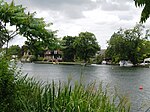Wraysbury Skiff and Punting Club
Organisations based in SurreyRowing clubs of the River ThamesRowing in BerkshireSport in SurreySports clubs established in 1931 ... and 1 more
Use British English from December 2016

Wraysbury Skiff and Punting Club (WSPC) is an English skiff and punting club founded in 1931 based on the River Thames at the start of the Surrey section of the right bank – between the rest of Runnymede (the meadow in the borough of the same name) and Bell Weir Lock (founded as Egham Lock).
Excerpt from the Wikipedia article Wraysbury Skiff and Punting Club (License: CC BY-SA 3.0, Authors, Images).Wraysbury Skiff and Punting Club
Riverside, Borough of Runnymede
Geographical coordinates (GPS) Address External links Nearby Places Show on map
Geographical coordinates (GPS)
| Latitude | Longitude |
|---|---|
| N 51.441711111111 ° | E -0.54913888888889 ° |
Address
Wraysbury Skiff and Punting Club
Riverside
TW20 0AA Borough of Runnymede
England, United Kingdom
Open on Google Maps









